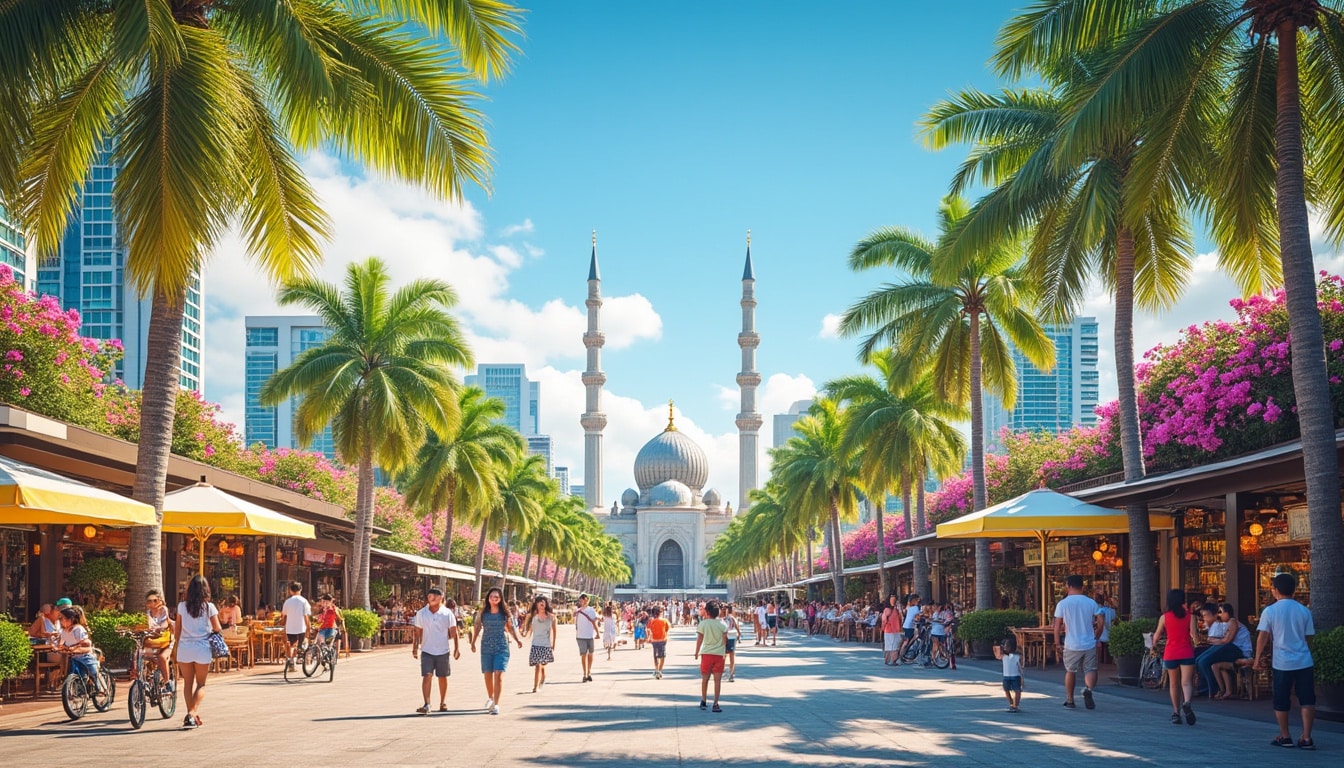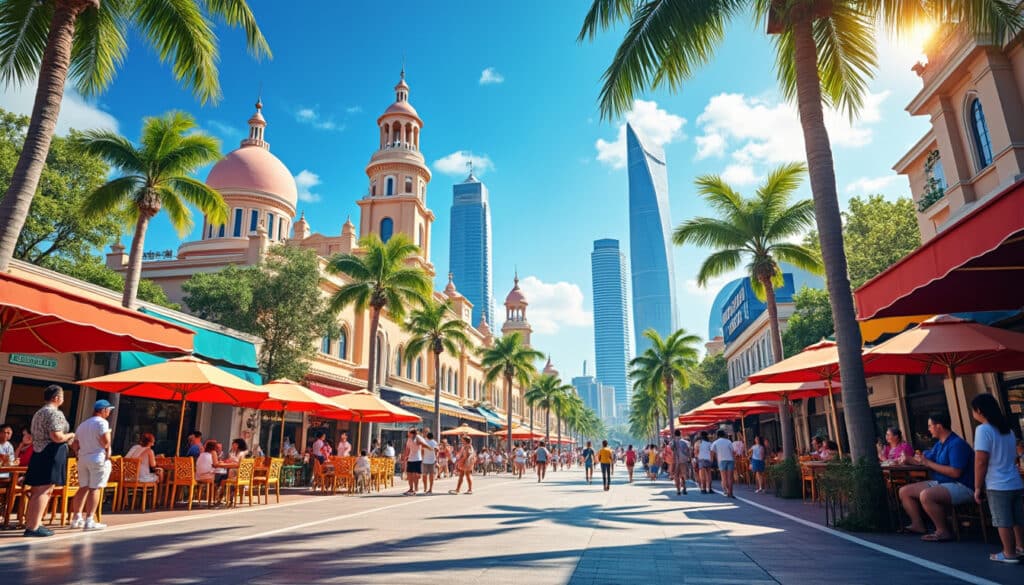For urban explorers and street food enthusiasts alike, Johor Bahru, Malaysia, constantly offers an intriguing play of weather conditions. With its unique tropical climate and inviting warmth, the city greets travelers year-round with its blend of modern attractions and rich cultural heritage. Known for its consistently high temperatures and humidity levels, the city’s weather invites curiosity about its potential for both sunshine and showers. While Johor Bahru remains a warm destination no matter the season, understanding the intricacies of its weather patterns can provide insights for those seeking the perfect time for exploration within this vibrant urban landscape.
Yearly and Monthly Weather Patterns in Johor Bahru
Johor Bahru, the dynamic border city in southern Malaysia, stands out for its tropical rainforest climate. The city’s average temperature embraces a steady range, bouncing between a mild 27°C and a sultry 32°C. What’s particularly interesting about Johor Bahru is the minimal temperature variation throughout the year, which means that warm weather is indeed a constant companion for residents and visitors.
Despite the stable warmth, the city experiences distinct wet and dry seasons, a characteristic of tropical climates. From June to August, Johor Bahru basks in its dry season, presenting an ideal window for sightseeing and outdoor activities. During these months, the mercury dances between 24°C and 30°C. The scant rainfall ensures that the city’s attractions are fully accessible and enjoyable.
Rainfall Patterns play a significant role in defining the rest of the year. As the city transitions to its wet season, September through February, rainfall becomes a frequent companion. Although temperatures remain warm, averaging between 24°C and 29°C, November and December often witness the heaviest downpours. Interestingly, the city receives an impressive annual rainfall, exceeding 2,300mm, resulting in lush greenery that beautifully complements its urban aesthetics.
Much of Johor Bahru’s precipitation is driven by the Northeast Monsoon (Nov-Mar) and the Southwest Monsoon (May-Sept). These monsoons influence cloud formation, rains, and even wind patterns over the city. The weather here is intricate, where frequent thunderstorms play both artistic and climatic roles in the city’s tapestry.
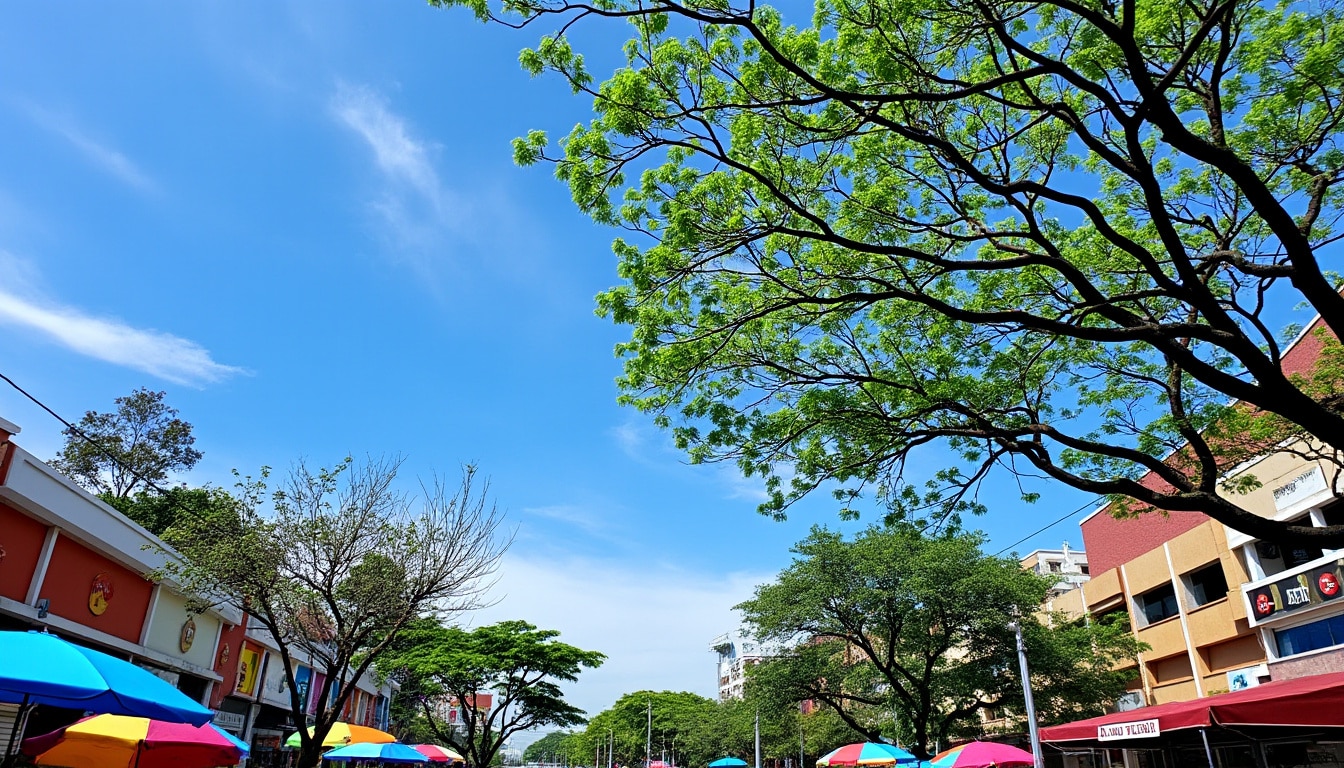
A look at the city’s cloud formations complements this picture: Cumulus, Stratus, and Cirrus clouds weave through the sky, each telling a piece of the climate story through their shapes and effects on sunlight and precipitation.
Exploring Humidity and Its Effect on Johor Bahru’s Climate
Humidity in Johor Bahru forms an essential part of the city’s weather discourse. Typically hovering around an unwavering 80%, the moisture content in the air contributes significantly to the region’s tropical feel. This level of humidity affects both daily life and visitor experiences, from comfort levels to travel plans.
Why does Johor Bahru experience such high humidity? Several factors are at play. The city’s proximity to the equator results in a consistent influx of moist air masses from the Indian and Pacific Oceans. Furthermore, Johor Bahru’s coastal location enhances its exposure to sea breezes, delivering additional humidity into the atmosphere.
Yet, understanding how this impacts experiences on the ground is key. For travelers, packing lightweight, breathable clothing becomes crucial, as does plenty of hydration. High humidity also means greater chances of perspiration. Interestingly, evening temperatures generally offer respite, dipping to a more relaxed 23 to 26 degrees Celsius, creating conducive conditions for enjoying outdoor markets or alfresco dining.
Seasonal Humidity Patterns reveal that the monsoon season brings even more moisture, with rainfall amplifying humidity levels. This contributes to lush natural scenery, perfect for activities like hiking or exploring Johor Bahru’s parks and gardens. Meanwhile, the drier months provide slightly more bearable humidity, making them ideal for attending local festivals or visiting cultural landmarks.
For a closer look at this intriguing aspect of Johor Bahru’s climate, check out detailed insights on humidity levels in Johor Bahru and how residents adapt to these conditions.
Rainy Days and Beyond: Understanding Johor Bahru’s Precipitation Patterns
Rainfall in Johor Bahru is nothing short of a character, occasionally unexpected yet always shaping the city’s experiences and scenery. On average, Johor Bahru delights in copious rain, especially from October through January. During these wetter months, the atmosphere buzzes with rain-soaked allure, offering a different kind of exploratory adventure. Yet, despite the frequent showers, the city stays overall warm, a testament to its tropical character.
This abundant precipitation is primarily the work of two monsoon systems: the Northeast Monsoon and the Southwest Monsoon. The Northeast Monsoon, particularly active between November and March, typically delivers heavy rains leading to occasional flash floods, but it also injects a fresh, rejuvenating element into Johor Bahru’s ecology.
Monthly Precipitation Trends show the city averaging 200–250 millimeters of rain monthly, ensuring that the landscapes remain lush and fertile year-round. Rain transforms the urban areas; gleaming roads, nourished trees, and welcoming parks offer photographers vivid opportune moments.
Despite the rain, Johor Bahru never loses its intrinsic warmth. The city manages to charm visitors event on drenched days with its blend of cultural allure and mouthwatering street food offerings. Plus, indoor attractions like the Johor Bahru Heritage Walk or local shopping havens offer shelter while exploring the chilly interiors often infused with air conditioning.
Through rain or shine, Johor Bahru provides an authentic tapestry of experiences that are further enriched by understanding its engaging climate story.
Sunlight and Warmth: The Endless Summer of Johor Bahru
Johor Bahru’s proximity to the equator gifts it with a unique advantage: persistent sunlight that paints a perpetual summer throughout the year. With sunrise typically around 6:30 AM and sunset close to 7:30 PM, days are long and inviting. During peak sun hours, particularly between 11:00 AM and 3:00 PM, sunlight bathes the city in energizing warmth, encouraging outdoor activities and adventures.
Given its tropical climate, sunlight in Johor Bahru plays a pivotal role in maintaining high temperatures, which rarely fall below the mid-20s even at night. This consistent warmth shapes the local lifestyle, influencing everything from food (think of ubiquitous durian stalls) to fashion (light, airy fabrics that drape locals and visitors alike).
Sun-Related Activities abound, with beach outings to Desaru or nature trips to lush parks offering perfect opportunities for both relaxation and exploration under the sun’s golden embrace. Additionally, street markets come to life with vibrancy, colors, and flavors as the sun sets, offering a feast for both the eyes and stomach.
The relentless sunlight contributes to significant solar energy potential as well, making Johor Bahru a burgeoning hub for renewable energy initiatives. The city’s dedication to sustainability sees these abundant rays harnessed to power homes and businesses, a step towards a greener future for Malaysia.
For more information, including detailed seasonal averages, visit Johor Bahru climate and weather. Whether basking under the sun or exploring shaded areas, Johor Bahru’s warmth is a constant embrace, marking it as a perennial warm destination.
Snow in Johor Bahru: An Improbable Fantasy
Johor Bahru, in its tropical glory, delights in warm temperatures throughout the year, a factor that firmly places snowfall in the realm of fantasy rather than reality. Given the consistently high temperatures, which rarely dip below 25 degrees Celsius, snowflakes simply can’t form under these conditions. The city’s equatorial position subjects it to a warm climate, where even the concept of snow is more of a whimsical thought than a weather forecast.
Several reasons contribute to this phenomenon. First, the absence of any significant altitude further quashes hopes of snowfall; there are no mountain peaks or cold zones where snow might materialize. Secondly, Johor Bahru’s coastal geography plays a role, as the sea contributes to mild, warm temperatures year-round, reinforcing conditions that thwart any potential for snow.
Despite this, the unique climate creates ample opportunities for tourists and locals to enjoy the outdoor lifestyle. From the sunny beaches of Tanjung Surat to vibrant local markets, visitors find their days packed with attractions that thrive under sunlit skies rather than snow-laden clouds.
For those looking for a snowy holiday within Malaysia, seeking higher altitudes or other parts of Southeast Asia would be more rewarding. Johor Bahru’s irresistible warm weather continues to offer an engaging escape for those favoring sun over snow.
Well-Rounded Weather Facts and Tips for Johor Bahru
| Aspect 🌡️ | Details 🌦️ |
|---|---|
| Temperature | Averages between 27°C to 32°C |
| Humidity | High, around 80% year-round |
| Rain | Heavy, especially Oct-Jan |
| Sunlight | Consistent, long days year-round |
| Snow | None, due to warm tropical climate |
Frequently Asked Questions
- 🌤️ Is Johor Bahru hot all year round? Yes, the city maintains warm temperatures averaging 27°C to 32°C throughout the year.
- ☔ When is the rainy season in Johor Bahru? The rainy season extends from September to February, with November and December seeing the most rainfall.
- ⚡ Does Johor Bahru experience thunderstorms? Yes, thunderstorms are frequent, especially during the monsoon seasons.
- 🌴 What clothing should I pack for Johor Bahru’s weather? Light, breathable clothing is recommended due to the high humidity and warm temperatures.

Climate & Weather in Johor Bahru
Johor Bahru’s climate is an intriguing mix of tropically lush landscapes and vibrant cityscapes. Positioned just above the equator, this bustling Malaysian city consistently experiences high temperatures and plentiful rainfall, making it a place of continuous warmth and humidity. As…
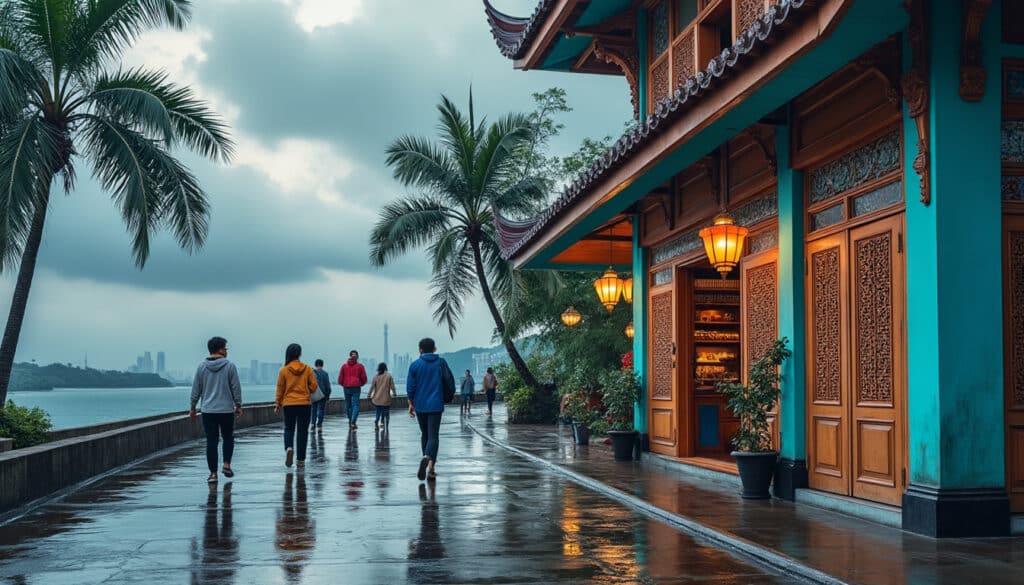
While Johor Bahru, Malaysia is often characterized by its tropical rainforest climate 🏝️, featuring high temperatures and abundant rainfall all year round, the city occasionally experiences periods of cooler weather that catch both residents and visitors by surprise. In this…

Flooding and natural risks in Johor Bahru
Floods can rapidly change the landscape of a city, and Johor Bahru is no stranger to this reality. The city, often recognized for its bustling urban life and rich culture, faces significant challenges due to recurrent flooding, exacerbated by seasonal…
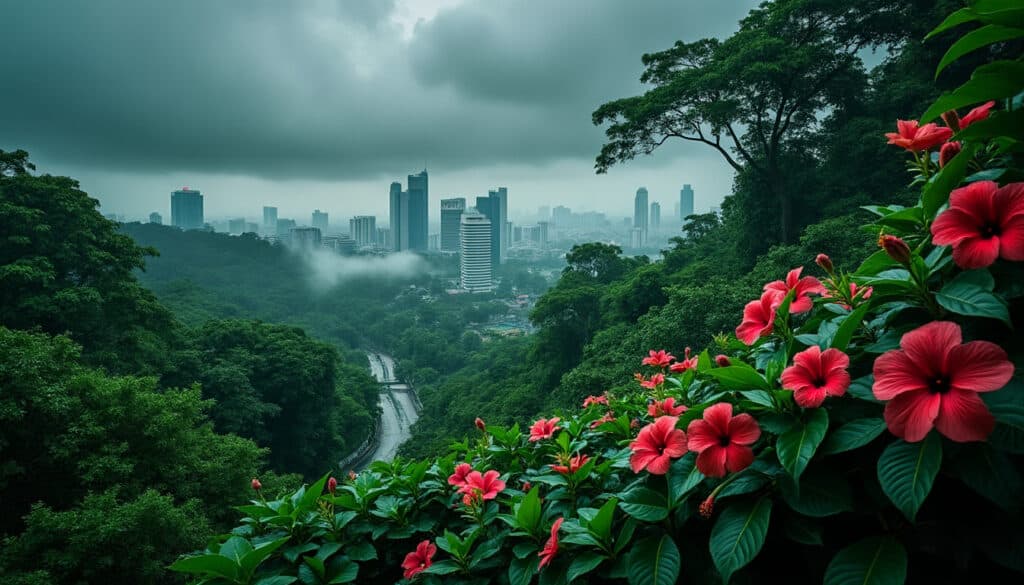
In the bustling city of Johor Bahru, nestled in the southern part of Malaysia, humidity is as omnipresent as the lush greenery and vibrant street markets that define the city’s landscape. This high level of moisture in the air shapes…
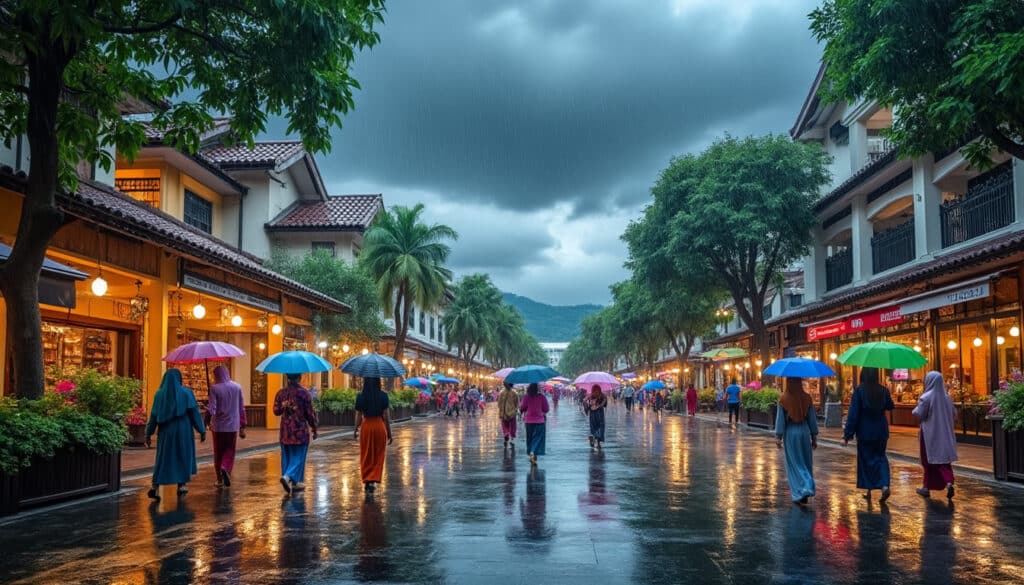
Rain and precipitation in Johor Bahru
The captivating city of Johor Bahru, nestled in the southern part of Malaysia, is renowned for its dynamic weather patterns that define the tropical rainforest climate. Tourists and residents alike experience the vibrancy of the climate characterized by continuous warmth…

Nestled at the southern tip of the Malaysian peninsula, Johor Bahru is a dynamic city that offers a captivating blend of urban life and natural wonders. With its tropical climate, the city experiences only slight variations in temperature throughout the…
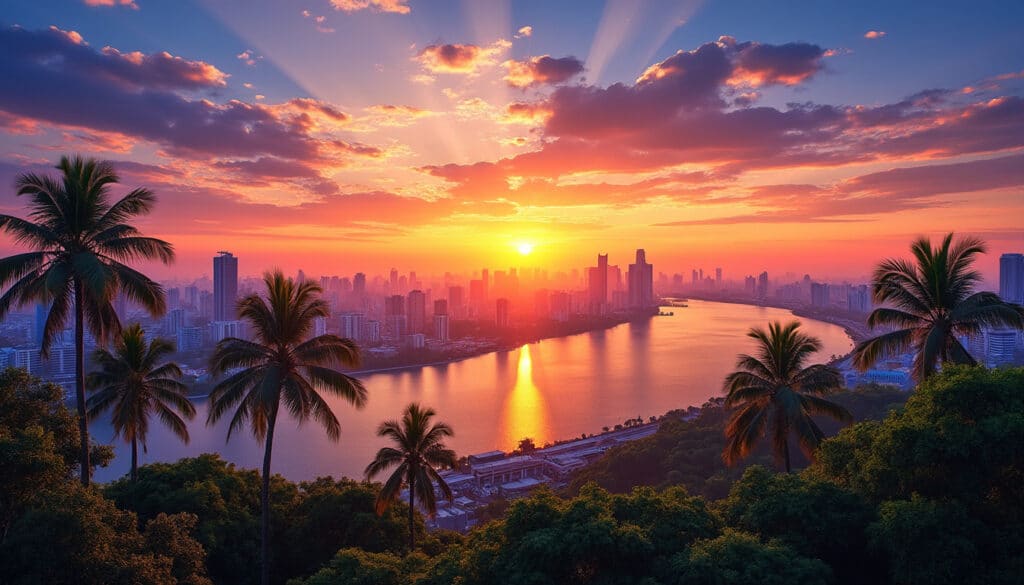
Johor Bahru, a vibrant city nestled in the southern part of Malaysia, is a place where the sun kisses the horizon with a unique charm. This metropolis, a haven for urban explorers, boasts enchanting sunrises that are cherished by both…

Weather in Johor Bahru by month
Johor Bahru experiences a tropical rainforest climate, making it a destination brimming with vibrant weather patterns. The city’s weather is shaped by its proximity to the equator, resulting in generally warm conditions all year round. Despite having a consistently tropical…
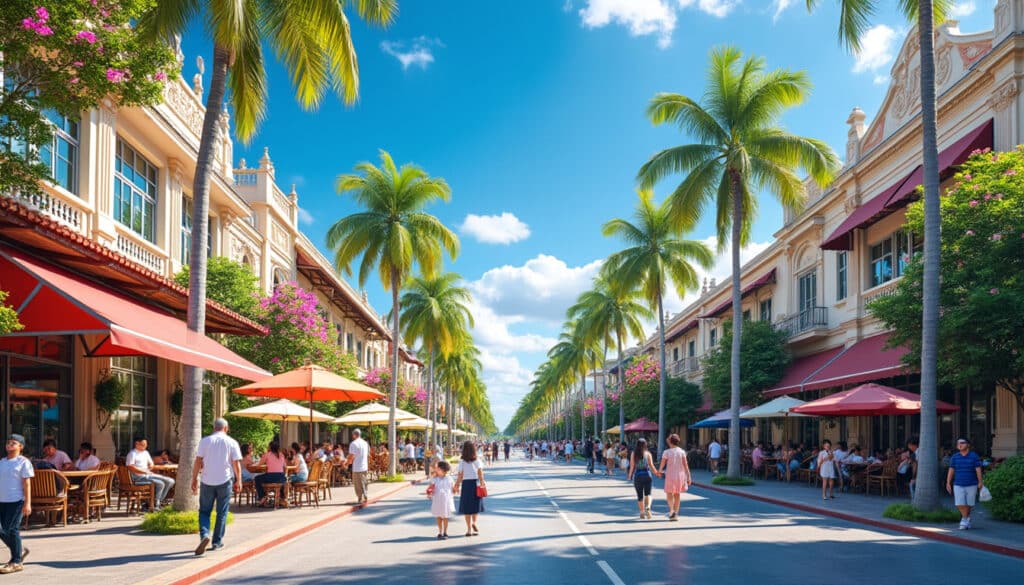
What is the weather like in Johor Bahru?
Experiencing the weather in Johor Bahru offers a dynamic adventure for any urban explorer or street food aficionado. The climate, characterized by warmth and tropical appeal, reflects the vibrancy of this Malaysian city. Whether you’re planning a visit or residing…

